Canard Limit Cycle of the Holling-Tanner Model
Abstract
By using the singular perturbation theory on canard cycles, we investigate the canard phenomenon for the Holling-Tanner model with the intrinsic growth rate of the predator small enough. The obtained result shows that there may be at most one canard limit cycle, and the range of small parameters is estimated. The phenomenon of outbreak is explained.
1. Introduction
It is easy to see that the set {(x, y): 0 < x ≤ K, y > 0} is positively invariant for (1), and there is always a unique positive equilibrium. The local stability of the positive equilibrium was analyzed in [2, 3]. In [4] Hsu and Huang considered the question of global stability of the equilibrium and obtained conditions under which its local stability implies the global stability. In 2003 Braza [5] investigated the existence of at least one limit cycle of (1) in a Hopf bifurcation. Gasull et al. [6] showed that (1) can exhibit two limit cycles by constructing an example. The bifurcation diagram of limit cycles of (1) was described to show the regions of parameters where two limit cycles or a semistable limit cycle appears [7]. Applying Andronov-Hopf bifurcation Theorem Hsu and Hwang proved that the Hopf bifurcation is subcritical and thus (1) may have at least two limit cycles for some parameter ranges and explained the phenomenon of outbreaking in [8] obtained by numerical simulations [9].
In the references mentioned above, it was assumed that all the parameters are positive constants, but there is not much consideration for the system with small parameters. It is interesting and important to analyze the bifurcation of limit periodic set of the system in the case when s1 is very small; that is, the intrinsic growth rate of the predator remains at a very low level. For this case when plotting the trajectories of system (1) with the intrinsic growth rate small enough by numerical simulations, it would take much longer time when the trajectory passes by the vertical y-axis. This behaves like the usual relaxation oscillation phenomena observed in slow-fast systems. By using the singular perturbation theory [10] Li and Zhu [11] studied the canard limit cycles for predator-prey system with functional response of four Holling types and developed criteria for the existence and multiplicity of canard slow-fast cycle (i.e., limit periodic set) in general predator-prey systems.
Although some references have considered the existence of two limit cycles for (1) [6, 7, 9], it is still interesting to discuss the existence of canard slow-fast cycle, since the canard slow-fast cycle consists of a part of the fast orbit and a part of the slow manifold and is the limit of a family of periodic orbits as the value of a positive parameter tends to zero. In this paper we mainly consider the existence of canard slow-fast cycle of (1) when s1 is very small. Our result shows that there may be at most one canard limit cycle, and the range of small parameters is estimated. In next section we first reduce the number of parameters to three ones by some transformation for (1) and introduce some concepts of canard slow-fast cycle. In Section 3 we provide the complete inferences for the main result of this paper. Finally we give discussion according to the results of numerical simulation.
2. Simplification of the Model and Canard Limit Cycle
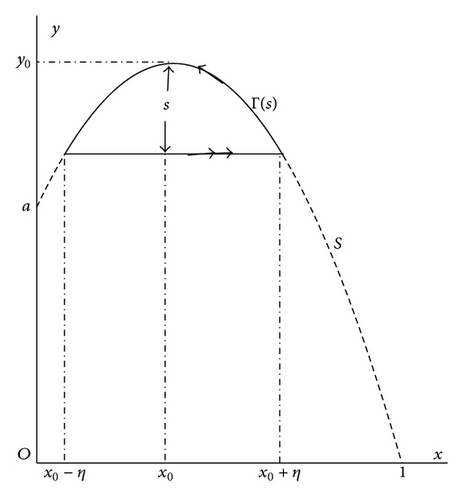
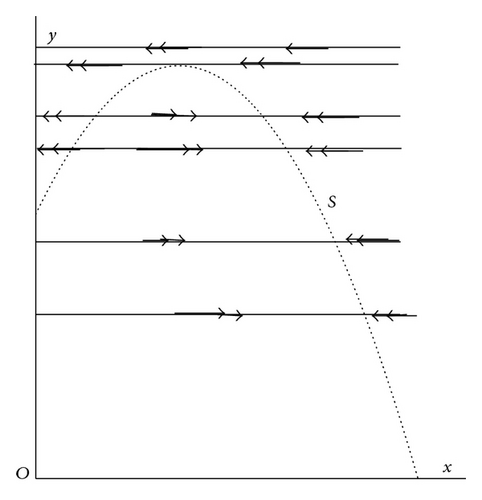
In order to show the existence of canard slow-fast cycle, from Figure 1(b) it is necessary to illustrate that the right hand side of (14) should be negative near the point (x0, y0).
In the next section, we will make some transformations such that the function g(x, y) in system (7) becomes , and for λ = 0 the right hand side of (14) is negative in an interval of x, containing x0; then we may construct a slow-fast cycle (i.e., limit periodic set) Γ(s) by combining a part of the fast orbit y = y0 − s, where s ∈ (0, y0 − a), and a part of the slow manifold S, shown in Figure 1(a). As we mentioned above, on the left and right sides of the point (x0, y0) the points on the slow manifold S are normally hyperbolic repelling and attracting, respectively, the point (x0, y0) is called a canard point, and the slow-fast cycle Γ(s) is called a canard type, or simply called a canard slow-fast cycle; see [10, 12].
3. Existence and Uniqueness of Canard Slow-Fast Cycles
The inequality (28) implies that, when there is a family of canard cycles bifurcating from the canard slow-fast cycle, λ in (7) depends on ε, and λ → 0 as ε → 0.
Summarizing the above inference, we obtain the following result.
4. Numerical Simulation and Discussion
We first plot the trajectories of (5) and the corresponding curves of x = x(t) and y = y(t) as δ = 3.2, a = 0.15, ϵ = 0.005, and λ = 0.001 (see Figure 2), in which Figures 2(b) and 2(c) illustrate the existence of the fast stages of x = x(t) and y = y(t).
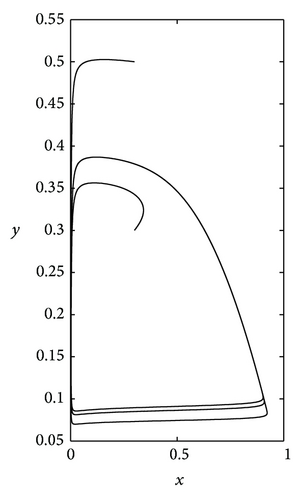
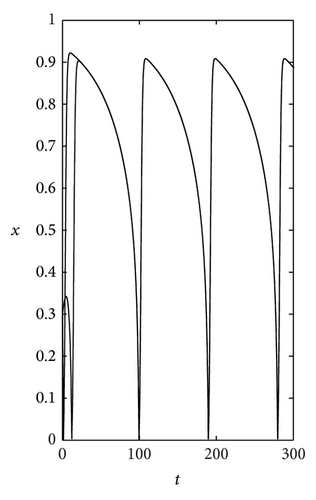
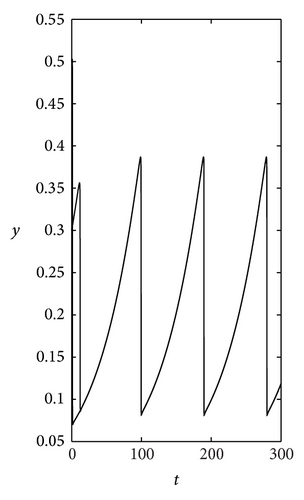
In order to more clearly show the fast stages, we locally enlarge the two curves in Figures 2(b) and 2(c) into Figures 3(a) and 3(b), respectively. From Figures 3(a) and 3(b), we can know that the fast stages of x = x(t) occur in region D1, and those of y = y(t) occur in region D3. Biologically, x = x(t) and y = y(t) represent the numbers of preys and predators at time t, respectively; then, when the intrinsic growth rate of the predator is very small and there exists the periodic solution for (1), according to signs of derivatives of x(t) and y(t) with respect to time t, the number of the preys increases quickly from the number small enough as (x(t), y(t)) ∈ D1, and the number of the predators decreases quickly as (x(t), y(t)) ∈ D3. The quick increase of the prey from the small value may explain the phenomenon of outbreak in [8].
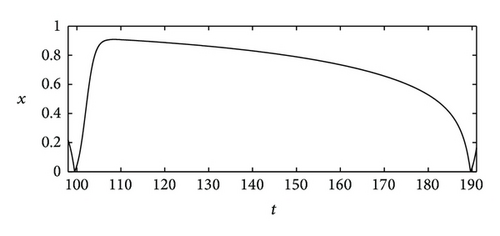
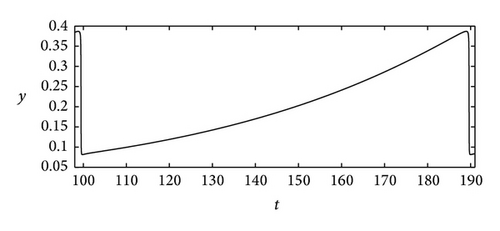
Conflict of Interests
The authors declare that there is no conflict of interests regarding the publication of this paper.
Acknowledgment
This work is supported by the National Natural Science Fund of China (nos. 11371369 and 11371313).




